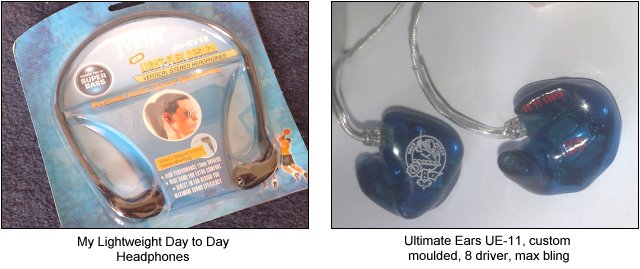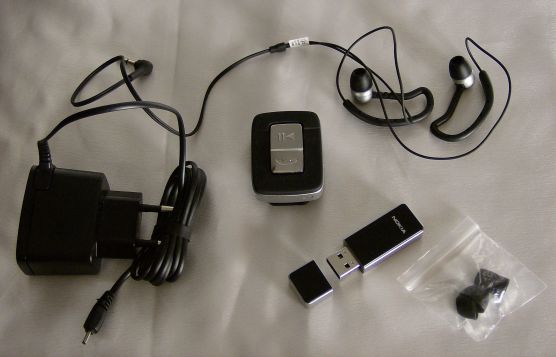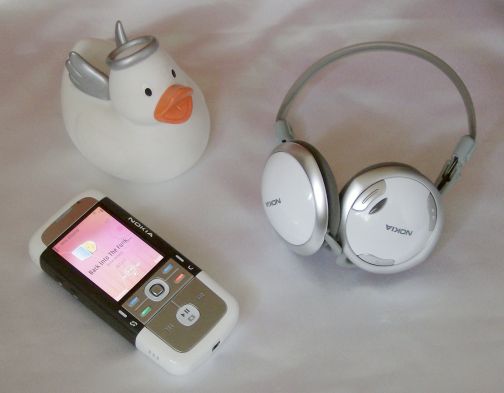You Can’t Always Get What You Want
“Here, try this,” shout Steve and Rafe, “you’re the music guy!” It’s the Nokia Bluetooth Headset (the BH-501 – reviewed here by Krisse) and, for an audiophile, it’s both understandable and surprising that I’ve waited this long to pick up a Bluetooth headset for my smartphone.
First of all, I’m pretty particular about my headphones. For day to day use, I’ve used a headband/in-ear design (on the left) consistently since I was about 12. On long travels, airlines, trains, etc., and for doing any audio work, I’m using a custom designed set of in-ears from Ultimate Ears (if you have to ask how much they are, they’re not for you). So switching back to the bulky and toy-like seventies style headphones is making me cringe.

A Change Is Gonna Come
Yes, these issues could be dealt with by the BH-500 , which is a little receiver box and has a 3.5mm stereo jack, so any set of headphones can be attached. Frankly that’s silly – the point of the headsets is they have a microphone as well so can be used to go hands free. If I’m going to have my own headphones being wired to a box that’s close to my person I might as well just slap them into the 3.5mm jack on a music phone, which most modern music targeted smartphones now have.

How would I sum up the Bluetooth stereo headset profile (technically labeled 'A2DP')? It’s the perfect embodiment of the 80/20 rule. It fits most of the bill, for most of the people, most of the time. While in principle everything works, streaming audio over Bluetooth, even at 750 odd kbps, there a lot of problems that kill the experience for me.
I Can’t Get No (Satisfaction)
The first is the totally random dropouts of sound – I can’t replicate it to order, but at some point either the audio processing that recompresses the audio signal before transmitting that to the headset decides to throw a wobbly and go silent for a second or two; or the decompression of the audio signal in the headset processor just runs out of music that’s ready to play (the post processing buffer runs out) so it goes silent while it all catches up. When your core function can be compromised as easily as this, then I’m going to be wary.
Both Nokia and Sony Ericsson have mitigated this to some extent by dropping the bitrate of the streamed music – other Bluetooth headsets that have user settings to change the streamed bitrate suffer more dropouts at these higher levels. They’ve obviously been turned down in these mass market headsets.
There’s also the actual music and what gets done to the audio signal. Listening to Johnny Cash for example, is a markedly different experience to Deep Purple. “The Ring of Fire” and “Jackson” seem to sit nicely in the area of music that’s easy to process for A2DP, but switch to the heavy rock “Fireball” and you’ve got problems. The number of clips on the bass lines was very off-putting.
“Fireball” and that range of Prog Rock from the seventies (and yes, Steve, that includes Hawkwind) cause some real problems. With solid and audible rhythms, and a huge amount of repetition in the tune, you start to notice it when A2DP wavers around a bit. The pitch of the music can slide up and down quite easily when you move around, and the tempo will drift around the solid beats per minute that Spinal Tap’s current drummer is punching out. Why?
While there is a bucket of bandwidth available to stream the audio, it’s not all used, and it's still another layer of compression to add on top of your MP3’s – and like MP3, it is also lossy compression, with information discarded to make the bit-stream smaller and more manageable.
That’s probably what’s causing the clipping on Fireball and the general distorition.

So what happens when there isn’t enough real time information to play the music? Well there are two options – the aforementioned cutting of the sound, or the music can be stretched out, so two seconds lasts two and a half seconds. And that’s textbook physics – increase the duration, and the pitch is going to drop. So if you’ve got a music file that needs a lot of decode/recoding work you’re going to hear relatively more stretched snippets and cutouts, than something that needs less CPU time.
The obvious answer is to either throw more processor time at the file (not an option on most fixed processor smartphones) or reduce the decoding complexity of the original file – 96kbps and 128kbp MP3’s are a lot more ‘stable’ than 192kbps or the 'almost CD' quality of 320kbps MP3. In time, Moore’s law should solve this little problem, of course, as smartphone processors double in computing power.
(Incidentally, this is also why, as the separation between phone and headset increases, the dropouts and audible errors increase. There’s less intact data reaching the headset, so more information needs re-sent, reducing the effective bandwidth, etc.)
So you can’t change the laws of physics, and you’re left with the 80.20 solution. Right now I can hear (no pun intended) a bundle of readers who are quite happy with their stereo headsets, who can happily live with these quirks, and are getting on with their life. And I can completely understand that point. It’s just that for me the compromises in both the music and the hardware are too much.
Killers
Personally, having to charge up yet another device when I am on the road is a big stumbling block. And when I’m on the road, trapped in the air in Economy class, you can’t use devices that transmit radio signals. So I need a wired solution there – I dread to think what a ten hour flight with no music would be like.
But the one killer problem I have that would stop me using this as a long term solution? It’s giving me a headache after about 20 minutes of listening. I’m using one of my N95 playlists, so I know that the music over both the light headphones and the Ultimate Ears (both shown at the top) doesn’t have the same problem in my head that the BH-501 generates.
This Is the End
Bluetooth stereo has been a long time coming, and it’s right that it gets to a level suitable for the mass market before pushing forward to capture the audiophiles – and for me the mass market level has been reached. But I think that, with the explosion in personal music consumption that the internet has created, and more specifically the music capable smartphones that hardware manufacturers and operators are pushing, there is still a huge scope for expansion in fidelity and stability. Right now, it’s not quite ready for me.
Ewan Spence, AllAboutSymbian, 8th October 2007
PS. Competition time. If you can identify the artist behind the track titles used for sub-headings in this feature, email ewanspence@gmail.com and the first one with everything right wins a Nokia phone charm!
